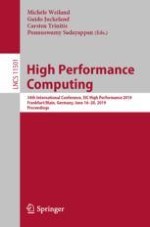2019 | OriginalPaper | Buchkapitel
Toward Efficient Architecture-Independent Algorithms for Dynamic Programs
verfasst von : Mohammad Mahdi Javanmard, Pramod Ganapathi, Rathish Das, Zafar Ahmad, Stephen Tschudi, Rezaul Chowdhury
Erschienen in: High Performance Computing
Aktivieren Sie unsere intelligente Suche, um passende Fachinhalte oder Patente zu finden.
Wählen Sie Textabschnitte aus um mit Künstlicher Intelligenz passenden Patente zu finden. powered by
Markieren Sie Textabschnitte, um KI-gestützt weitere passende Inhalte zu finden. powered by
